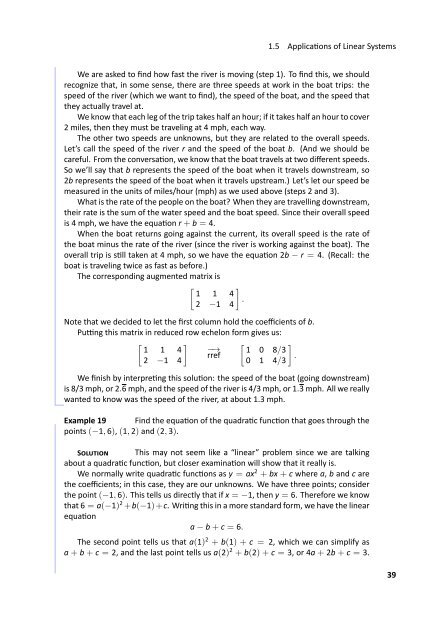Fundamentals of Matrix Algebra, 2011a
Fundamentals of Matrix Algebra, 2011a
Fundamentals of Matrix Algebra, 2011a
Create successful ePaper yourself
Turn your PDF publications into a flip-book with our unique Google optimized e-Paper software.
1.5 Applicaons <strong>of</strong> Linear Systems<br />
We are asked to find how fast the river is moving (step 1). To find this, we should<br />
recognize that, in some sense, there are three speeds at work in the boat trips: the<br />
speed <strong>of</strong> the river (which we want to find), the speed <strong>of</strong> the boat, and the speed that<br />
they actually travel at.<br />
We know that each leg <strong>of</strong> the trip takes half an hour; if it takes half an hour to cover<br />
2 miles, then they must be traveling at 4 mph, each way.<br />
The other two speeds are unknowns, but they are related to the overall speeds.<br />
Let’s call the speed <strong>of</strong> the river r and the speed <strong>of</strong> the boat b. (And we should be<br />
careful. From the conversaon, we know that the boat travels at two different speeds.<br />
So we’ll say that b represents the speed <strong>of</strong> the boat when it travels downstream, so<br />
2b represents the speed <strong>of</strong> the boat when it travels upstream.) Let’s let our speed be<br />
measured in the units <strong>of</strong> miles/hour (mph) as we used above (steps 2 and 3).<br />
What is the rate <strong>of</strong> the people on the boat? When they are travelling downstream,<br />
their rate is the sum <strong>of</strong> the water speed and the boat speed. Since their overall speed<br />
is 4 mph, we have the equaon r + b = 4.<br />
When the boat returns going against the current, its overall speed is the rate <strong>of</strong><br />
the boat minus the rate <strong>of</strong> the river (since the river is working against the boat). The<br />
overall trip is sll taken at 4 mph, so we have the equaon 2b − r = 4. (Recall: the<br />
boat is traveling twice as fast as before.)<br />
The corresponding augmented matrix is<br />
[ 1 1 4<br />
2 −1 4<br />
Note that we decided to let the first column hold the coefficients <strong>of</strong> b.<br />
Pung this matrix in reduced row echelon form gives us:<br />
[ ]<br />
[ ]<br />
1 1 4 −→ 1 0 8/3<br />
rref<br />
.<br />
2 −1 4<br />
0 1 4/3<br />
We finish by interpreng this soluon: the speed <strong>of</strong> the boat (going downstream)<br />
is 8/3 mph, or 2.6 mph, and the speed <strong>of</strong> the river is 4/3 mph, or 1.3 mph. All we really<br />
wanted to know was the speed <strong>of</strong> the river, at about 1.3 mph. .<br />
. Example 19 .Find the equaon <strong>of</strong> the quadrac funcon that goes through the<br />
points (−1, 6), (1, 2) and (2, 3).<br />
S This may not seem like a “linear” problem since we are talking<br />
about a quadrac funcon, but closer examinaon will show that it really is.<br />
We normally write quadrac funcons as y = ax 2 + bx + c where a, b and c are<br />
the coefficients; in this case, they are our unknowns. We have three points; consider<br />
the point (−1, 6). This tells us directly that if x = −1, then y = 6. Therefore we know<br />
that 6 = a(−1) 2 +b(−1)+c. Wring this in a more standard form, we have the linear<br />
equaon<br />
a − b + c = 6.<br />
The second point tells us that a(1) 2 + b(1) + c = 2, which we can simplify as<br />
a + b + c = 2, and the last point tells us a(2) 2 + b(2) + c = 3, or 4a + 2b + c = 3.<br />
]<br />
.<br />
39

















